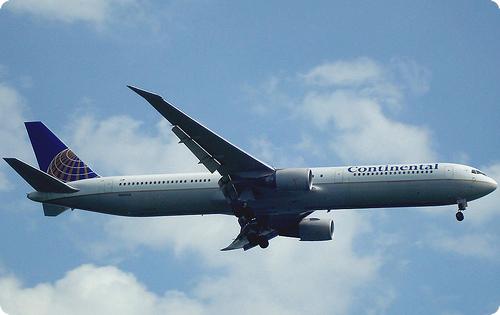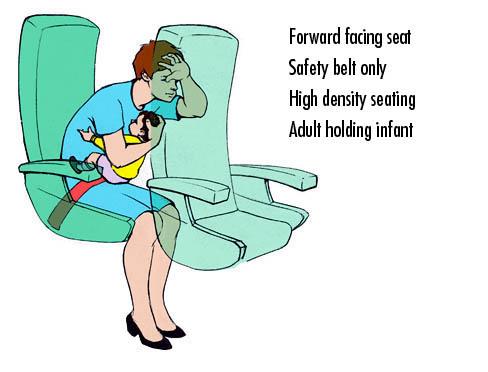Can You Keep an Infant Safe in Extreme Turbulence?
By now, you've probably heard about a recent Continental Airlines flight in which extreme turbulence injured 26 people and caused the flight to make an emergency landing.

It's easy to ignore the dangers of turbulence. We have all experienced mild turbulence at some point, and injuries are rare. Most of us assume that there will be time to assume a brace position, or in the case of a lap infant, to hold them tight, as the turbulence begins. That's why I found these two quotes from the article particularly frightening.
... passenger, Fabio Ottolini, said some flight attendants who were standing in the aisles when the turbulence hit were thrown against the roof.
"People didn't have time to do anything," AP news agency quoted him as saying.
Without a doubt, the safest place for an infant or young child is properly secured in a car-seat or an FAA approved safety harness like CARES.
With the high cost of airfares, though, a separate seat for a child under two can seem like a luxury. The FAA allows parents to carry infants on their laps instead of requiring them to buy a seat because statistically it is safer than having them all drive to their destination. If you cannot purchase a separate seat for your child, I recommend flying at a time of day when flights are typically not full so that you can place the child (in their restraint) in an empty seat.

Adults holding infants should provide as uniform support as possible to the infant's head, neck, and body, and lean over the infant to minimize the possibility of injury due to flailing.and Transport Canada advises:
- The infant should be held sitting upright (so that his/her back is in a "vertical" position) and face the adult. A larger infant may need to straddle the adult's hips.
- The adult should place one arm around the infant's torso and head and place the other arm against the seat back ahead of the adult, and rest his/her head firmly on this arm.
- The adult should then lean forward so the infant is held in the space formed between the adult and the forward seat back. It is very important for the adult to lean forward as much as possible to protect the infant; the closer the adult is to the seat back ahead, the better.
An infant should not be placed across the adult's lap (in a horizontal position); this could result in the infant's head impacting the arm rests during lateral aircarft movements.
Reader Question: Has the recent spate of emergency landings and crashes changed your mind about flying with a lap infant?
13 comments |
Posted on August 5, 2009 |
 Save to del.icio.us
Save to del.icio.us


Comments
Caroline on August 5, 2009 at 8 p.m.
Qantas provides a seatbelt for lap children on their Australia/U.S route. It is a belt that gets attached to the adult's seatbelt that gets fastened around the lap child just like an adult seatbelt. I have used this on a 7-8 month old and an almost two year old. It definitely helped during turbulence. There always seems to be a lot of turbulence on transpacific flights. United did not provide a similar belt on a transpacific flight to/from Australia/U.S. with a lap child.
Kelley on August 5, 2009 at 10:09 p.m.
Thanks for posting this. We are a family that has been traveling with our girl, currently 21 months without purchasing an additional seat because we do think of it as a luxury to not have to until she is 2. I have wondered about this for awhile and it is a fear that has crossed my mind. We have been very lucky to have an extra seat many of our flights both domestically and internationally. We took our carseat on once and that was a disaster for us but perhaps had we used it more it would be better. When she turns 2 we know we will have to use a carseat for flights because she is so small and couldn't just sit in a seat.
Another thing I have wondered about are the bassinets that many airlines offer, how does that work if there is turbulence, it almost seems like there could be more harm with those.
Caroline on August 6, 2009 at 11:09 a.m.
When using a bassinet, if the seatbelt sign is on you have to take your child out of the bassinet and hold on to them. That is my experience with using a bassinet on Qantas.
Jessica on August 16, 2009 at 12:46 p.m.
If you do choose to fly with a lap child, always ask if you can use your car seat when checking in anyways. We flew numerous times when my first child was under 2, and only had this request refused once, even on supposedly full flights, which I suppose says something about the importance airline employees place on having infants in car seats!
I'm not sure this will work as well in these economic times, but it certainly doesn't hurt to ask.
Debbie on August 16, 2009 at 3:04 p.m.
@caroline Some international airlines use the lapbelt (American airlines do not) it depends on which countries flight rules the airline is governed by. Interestingly, not all carriers will allow you to place an infant in a rear facing car seat during takeoff and landing, so it is worth checking the rules before you fly.
@jessica Yes, if there is a free seat the airline will almost always allow you to install your infant seat.
La Rêveuse on August 16, 2009 at 5:19 p.m.
We bought a Baby B'Air to use with our daughter. When she was between 1 and 2, it helps for turbulence, but also to restrain her so she didn't try to take off and run down the aisles, especially on long flights to and from Europe. Flight attendants were great about rearranging flights to accommodate us (legally they have to give you the seat if there is a free one, btw), but this was an added big of reassurance, and at less than 40 bucks, was worth it. We've loaned it to friends, too. Some flight attendants won't allow use during takeoff and landing, but at least it was there for turbulence! http://www.babybair.com/
Maggie on August 16, 2009 at 6:05 p.m.
We do extensive international travel and have learned that while US carriers are very supportive and in fact encourage the use of car seats many international ones do not. In fact, in our experience, even though we have bought a seat for our less-than-two year old there are times we were not allowed to use it as the airline(s) disallowed the use of any and all carseats on their planes (ie Virgin flights in Australia).
Many other airlines require certification of the car seat prior to your arrival at the airport where you may still have to go through an extensive inspection, one took nearly an hour. We have a common, standard US carseat with the FAA approval sticker right on the side.
I've argued this safety point with many airlines, an infant is always safer buckled into a seat than loose in a lap, and the response I've gotten is that 1)not all carseats fit in planes (true in this time of shrinking seats) and 2)not all carseats are safer when buckled in with only a lapbelt, since they are designed to be buckled in with lap/shoulder in a car, as they may tip/fall in the case of emergency. I still don't agree, but this is the explanation I've gotten for denial.
Our child just turned 2 and has over 40 flights under his belt, and he's tall enough he doesn't need the car seat. I have to admit I'm glad, I won't miss the hassle :)
mai on August 16, 2009 at 10:36 p.m.
my MIL is a former flight attendant and she drummed into us the things that can happen during a turbulent flight. we always pay for the extra chair for our infants... for us it wasn't a luxury - it's kind of like having a car seat in your car... we just have to do it.
when news like this comes out - we're glad we do it. even if it means budgeting for that extra ticket(s) . we try to make sure to have a enough mileage to cover the cost of one of the kids- or use a companion certificate ($50/$99 on Alaska).
with that being said... i had my daughter in her car seat on my last flight - and the turbulence was so bad, i wondered at what point is it like shaking a baby? you start to freak out about it. i was tossed back and forth in my seat and had a bad headache from it...
Julie on August 17, 2009 at 5:13 p.m.
We too have felt like a seat for our child wasn't a luxury, but something mandatory. Like when I went to a bike helmet years ago thinking I'd get a cheap one. "How much is your head worth to you?" the man asked me.
Jessica, when you do get a seat for your child you can use a kids seat belt from CARES Kids Fly Safe instead of lugging the car seat. It's FAA approved and easy to use.
We recently rented one (on Ebay from Susan in NJ who was great to work with) for $13 + tax, shipping, and return postage for our turned-three-during-the-trip son. They are around $80 new which might be worth it if you fly more than two or three times/year.
R. Campbell on August 17, 2009 at 9:03 p.m.
Our daughter has flown twice--we used the CARES restraint both times. I would certainly recommend it to anyone--you can easily "rent" them from reputable sellers on ebay, like my family did, if you don't fly that often or don't want to pay full price for one. I wouldn't ride in a car with my daughter unbelted; I certainly wouldn't ride in a plane without a seat belt that fit properly!
R. Cardoso on August 19, 2009 at 10:41 a.m.
Just to throw my 2 cents in - from what I understand, turbulence-related issues are not as much a problem as what the FAA calls a "runway incursion". Same mechanics as a car accident, but in a plane (which makes me wonder why airlines don't offer shoulder belts/harnesses for adults to use). That was what decided it for me on lugging a car seat on for a 12 mo. Some of the Southwest staff was great about it (the PILOT carried the seat back for me), but the FA's were obnoxious - asking me repeatedly AFTER I got everything buckled in, settled in, etc. whether or not I had purchased a seat for her. Yes, I did, but it would be a crappy time to tell me if I hadn't and make me undo it all.
louise on August 22, 2009 at 8:46 p.m.
We'll be travelling soon with our 2-1/2-yr-old and 15-month-old. We bought a seat for the older boy and so he'll be safe in his carseat, but I plan to use our toddler tether harness (you know those things that you put on your toddler to keep them from running away and it makes them look like a dog?) -- I've never actually needed it till now and I'm happy to have thought of a good use for it! I'll loop it through my own seatbelt and will feel reassured that if we do encounter turbulence (or heaven forbid, a runway incursion), at least I won't completely lose the baby!
Debbie on August 22, 2009 at 8:54 p.m.
@louise good luck! Most US airlines will make you remove your child from any sort of harness that attaches them to you (eg a sling) during takeoff and landing).